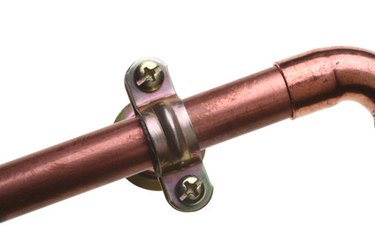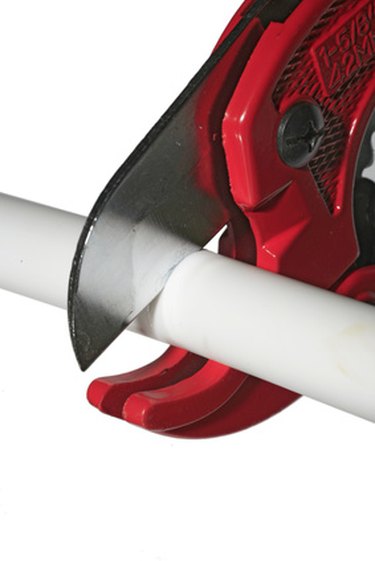
Copper pipe is one of the most common materials used for installing water supply lines in both residential and commercial buildings. PEX (cross-linked-polyethylene), a newer kind of pipe, has been used for years in Europe and Canada and is approved for use in the United States. Both kinds of pipe have their advantages and disadvantages, making them more suitable for different installation situations and less suitable for others.
Ease of Installation
Video of the Day

Installing copper requires skill and preparation. Copper is a soft metal, and is therefore easy to cut with a single-track tubing cutter. But copper pipe is rigid and inflexible, so creating a long water supply line requires carefully calculation of pipe lengths and changes in direction in order to ensure a proper installation. By contrast, PEX pipe is light and moderately flexible, and can be guided through tight spaces more easily than a rigid copper pipe can. This makes running a new line through an existing house wall the perfect job for PEX. PEX is also easy to cut using a ratcheting PVC cutter.
Video of the Day
Making Connections
Copper pipe connections requires a careful, deliberate technique called "sweating" the pipe. This involves cleaning the pipe, applying flux, heating the pipe with a torch, soldering the joint, then cleaning it again. This technique must be practiced, and may be intimidating to the beginning do-it-yourself plumber, but results in strong, durable joints when executed properly. PEX connections are made using metal crimped fittings. The end of the PEX pipe is pushed onto a metal fitting, then secured by crimping a metal band around the pipe with a crimping tool. Crimping is more easily mastered than soldering, making PEX a more attractive option for novice plumbers.
Durability
Copper is quite durable, and is not damaged by UV rays like PEX pipe is; PEX should therefore not be used for exposed outdoor applications. Copper pipe can split if water freezes inside it, but minor cases of frozen copper pipes can be remedied by heating the pipe with a torch. PEX can withstand moderate and hard freezes without breaking, and retains hot water heat better than copper pipe does. Copper corrodes if exposed to aggressive (hard) water, while PEX is unaffected by the same kind of water.
Cost
Copper has the reputation of being an expensive material to plumb with, though if properly installed, it will return the investment with decades of durability. PEX pipe is less expensive than copper pipe. But PEX fittings can add extra cost to a project, especially when installing a long or complicated water supply system.
Availability
Copper pipe and PEX pipe supplies are both available at major home improvement stores. Specialty fittings and equipment (such as some varieties of PEX crimping systems) can be obtained from plumbing supply specialty stores.